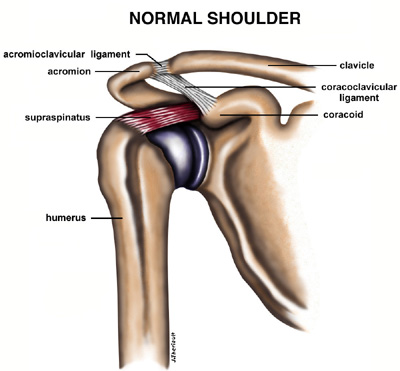
Shoulder Impingement, Bursitis & Tendonitis

Injury Description
This is one of the most commonly occurring injuries in sports where the arm is used in an overhead motion (i.e. swimming, baseball). The pain is usually felt on the tip of the shoulder or part way down the shoulder muscle. The pain is felt when the arm is lifted overhead or twisted in a certain direction. In extreme cases, pain will be present all the time and it may even wake the injured individual from a deep sleep. Throwing a baseball overhand or working overhead may become impossible.
Anatomy
The tendons of the muscles that life the arm, and the associated bursa (fluid filled sac that prevents friction) go through a very tight channel of bone (see diagram). When the arm is raised, the channel becomes smaller and makes the area very prone to inflammation. When the arm is used overhead, it can bring the asymetric bony prominence of the humerus to pinch or "impinge" against the roof of the shoulder joint. This pinches the rotator cuff and leads to tendonitis. Overtime it can actually tear the rotator cuff.
Predisposing Factors
- Overuse: This is the most common cause of the problem and the result of repetitive overhead motions.
- Weak muscles: When the muscles are weak more force is exerted on the tendons and bursea causing inflammation and pain (tendonitis, bursitis).
- Improper or inappropriate swimming or throwing techniques.
- Strenuous training: One hard throw may start the problem.
- Previous injuries to the shoulder.
- Loose shoulder joint.
- Calcium deposits.
- Impingement of osteophytes (bone spurs) on the shoulder joint causing impingement syndrome.
 Treatment
Treatment
Rest: Use pain as your guide. You are only aggravating the condition if you continue your activity while experiencing pain. In very bad cases, you should refrain from using your arm for all daily activities (lifting briefcase, opening doors).
Ice: In the early, painful stage, apply ice (frozen peas) to your shoulder twice a day for 15 minutes. Always apply ice for 15 minutes after any activity using your arm.
Range: When use of your arm is limited, range exercises must be done twice daily. Bend at the waist and let your arm hang down. Then make large circles with your arm. These pendulum exercises will prevent your shoulder from becoming stiff.
Physical Therapy: The physical therapist will initially try to reduce the inflammation in your shoulder. Later, therapy will be designed to strengthen the shoulder to prevent the problem from recurring.
Medication: Your doctor may prescribe anti-inflammation pills. These could form a very important part of the treatment.
In certain circumstances an injection of cortisone into the shoulder may be indicated. It is usually a secondary treatment to supplement other therapy. After an injection you should not attempt any vigorous activities with your arm for a week to ten days.
Surgery: Sometimes surgery is required to treat this condition. If calcium deposits occur or impingement is present, surgery may be necessary to remove these problems.
Risks: Stiffness, infection, nerve, or blood vessel damage, bleeding, persistent symptoms, phlebitis, anesthetic problems, pneumonia, etc. MAKE SURE YOU UNDERSTAND ALL OF THESE PRIOR TO SURGERY.
Rotator Cuff Tears: If the muscle is found to be torn at arthroscopy, a repair may be necessary.
Sports
General Principles
It is the overhead motion of the arm that aggravates this condition. In severe cases all sports using the arm should be avoided. When you go back to your sport, go back slowly. Throw easily and do not play for a long duration of time. Slowly increase the strength of your arm and the intensity of your game. In some sports you can avoid the overhead motions (i.e. tennis, squash).
Throwing Sports
Initially an underhand or side-arm throw will be easier than an overhand throw. Warm up well. Throw easily and gradually increase to harder throwing. Try and maintain a smooth throwing motion. This will use more of your body strength and relieve the pressure on your shoulder.
Swimming
Breast stroke or side stroke will be easier than front crawl or butterfly strokes. Sometimes the back stroke causes less pain. Perform any hard swimming (sprints) early in your swimming workout before you are fatigued. Consult a swimming coach to see if a change of your swimming style can help relieve the problem.
Exercises
Do not attempt exercising while the pain is severe. After the pain has subsided, it is of utmost importance to strengthen the shoulder muscles in order to prevent the condition from recurring. Exercise will be taught to you by your physical therapist.